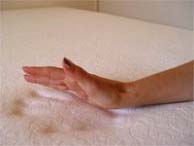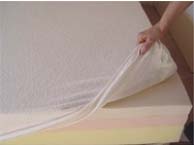

I have always taken an interest in the technological advancements that NASA brings to the space community. However, I have to say that I never would have dreamed that one of these advancements would eventually find its way to my bedroom.
The advancement I am referring to is what many people have come to know as memory foam, a technological advancement that NASA developed in the 1970s that allows foam to mould to your body and then return to its original shape once your body moves to a new position.
I have been coveting one of these mattresses for years, but like many consumers was not ready to shell out the extra dollars for a new mattress, let alone one that I knew was bound to cost much more than a traditional spring mattress.
However, one recent uncomfortable and sleepless night, I found myself spending hours researching all there was to know about memory foam mattresses. While I may be a professional researcher by trade, I have to admit that at first I was a bit confused as to which company produced the best memory foam mattress.
I had already heard about the Tempur-Pedic. They were the first company to use NASA's technology for the purposes of consumer bedding. However, I had read that the use of their five pound density foam was too temperature sensitive, and the overall feeling of the mattress was too hot.
From what I could gather, due to the high viscosity of the memory foam that Tempur-Pedic uses, it could feel too firm in cooler temperatures and even too soft for some people when it was heated up. Not being one to be easily discouraged, I continued my investigation and learned that there was a new innovation that solved this dilemma, but more on this in a moment.
What I did readily notice during my investigation was that there were other companies producing memory foam mattresses that were reported to be just like Tempur-Pedic, but a bit less costly. However, upon further examination many of these companies were using inferior quality foam and I did not feel comfortable that it would stand the test of time.
Then I came upon a new mattress that didn't just try to use NASA's technology and copy Tempur-Pedic. Rather, they were using innovation to improve upon the use of NASA's technology in a design that could answer the concerns that Tempur-Pedic and other memory foam mattress consumers seemed to want addressed.
This new mattress is called the Tri-Pedic. The mattress is relatively new on the market when compared to some of the older and well established names out there, but it was actually developed about five years ago. What makes the Tri-Pedic more innovative than the competition, is that it found a way to address some of the previously mentioned Tempur-Pedic and other five pound density memory foam mattress concerns.
It did this by creating the first three layer memory foam mattress with two different densities. The top layer uses a softer four pound density memory foam that was not nearly as temperature sensitive, and had a more instantly plush feel to it.
Not wanting to lose support they followed this up with a second layer of memory foam that has a firmer and more supportive five pound memory foam. For the third layer, the Tri-Pedic used a very firm and highly durable base foam.
Their confidence in the longevity of the mattresses they sell on Selectabed.com has lead them to offer a 30-year warranty. They also offer a 4-month sleep trial to ensure that your are completely satisfied with your mattress. Selectabed.com is a division of the actual manufacture, Relief-Mart, Inc.
On behalf of Space Daily I ordered Tri-Pedic mattresses for myself, as well as a member of my staff. I will readily admit that I selfishly was hoping to improve my own sleep while testing this mattress on a personal level and rendering an opinion.
Fortunately for Selectabed.com, my staff and I have been thoroughly impressed by how the mattress feels and the level of support that it gives. Therefore, we unanimously decided to give the Tri-Pedic mattress our Space Daily product innovation award for finding a way to improve upon the use of NASA's technology and literally helping to make dreams come true.
MORE NEWS....
Whether you are suffering from back pain, neck pain, arthritis, bursitis, tendonitis or you just need to get a better night's sleep, the Tri-Pedic™ pressure sensitive memory foam mattress may be just what the doctor ordered. Created by Dr. Rick Swartzburg, D.C., to help his patients suffering from all types of pain, the Tri-pedicÔ is the first three layer, pressure sensitive memory foam mattress with three different foam densities. We normally sell 4lb., 4.5lb. and 5lb. densities. Through listening to all of our customer feedback, we have learned that each density has it's own advantage. A 5lb. density is more expensive than a 4lb. density, but it will support you better, and be more temperature sensitive. Although a 5lb. density is what *Tempur-pedic® uses on their mattresses, many of our customers have reported that it is can be too hard when used by itself, especially in cold temperatures. On the other
hand, the soft and plush feeling of a 4lb.ensity makes you instantly comfortable, but lacks the extra support of a 5lb. density. Therefore we are proud to feature the Tri-Pedic™, the first three layer, pressure sensitive, memory foam mattress with 3 different foam densities to give you immediate comfort, with the best support system available. The top two levels total over 4 inches of the highest quality memory foam available for an 8 inch total mattress. We use a very our special 4lb., 10 ILD memory foam over the higher density 5lb., 20 ILD memory foam. We follow this up with a very supportive high resiliency polyurethane base. The Tri-Pedic™ memory foam mattress uses our specially designed hand stitched hypoallergenic, stretchable terry cover that is easily removable for washing. It has a special breathable design that will ventilate better than most covers to keep your body temperature constant, so you will not have to worry about this mattress getting too hot. The Tri-pedicÔ mattress is soft enough to contour to the bumps and curves of your body, but firm enough to provide proper support and will never bottom out. The Tri-pedicÔ uses similar density memory foam as the Tempur-pedicÒ , but never gets hard when the room temperature drops. We are so convinced that you will not find a more comfortable mattress that we are offering a 4-month trial that includes the option of having us pay for the shipping of another mattress if you are unsatisfied for any reason at all. We also back this mattress with a 30-year limited warranty. The Tri-Pedic™ has even been tested and given the award for space technology innovation in the market place for 2005 by the very prestigious global online news source - SpaceDaily. As you can tell we are extremely proud of this mattress and want you to experience first hand why the Tri-Pedic™ and Soft-pedic™ are the best mattress you will ever own!
Technorati : Brings, Further, Innovation, Mattress, NASA's, Tri-Pedic, echnology
 The European Space Agency's (ESA) postage-stamp-sized experiment, called the "Life Marker Chip" (LMC), was launched last week aboard a Russian rocket launched from Baikonur Cosmodrome, Kazakhstan.
The European Space Agency's (ESA) postage-stamp-sized experiment, called the "Life Marker Chip" (LMC), was launched last week aboard a Russian rocket launched from Baikonur Cosmodrome, Kazakhstan.

